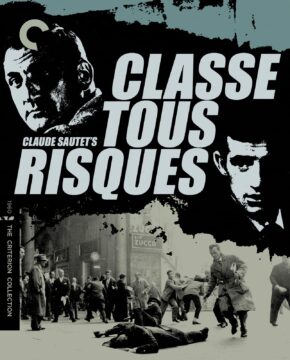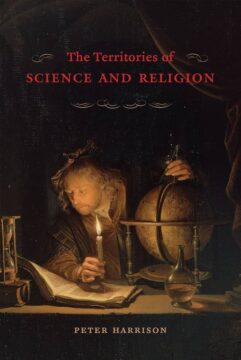Sean Nam at The Baffler:
 When the French crime film Classe tous risques—the English title, The Big Risk, fails to capture the pun on insurance policies and travel accommodations—premiered in Paris in March 1960, it was undercut by no less a modern heretic than Jean-Luc Godard, whose Breathless had premiered only a week before. Both films starred Jean-Paul Belmondo, an ex-boxer whose hardscrabble looks were belied by his soft pout. He plays underworld citizens in both films: In Breathless, the scapegrace Michel Poiccard, stroking his thumb across his lips in a pastiche of Humphrey Bogart, and in Classe tous risques a young louche named Éric Stark. The film’s director, Claude Sautet, was thirty-six at the time, having apprenticed for years as an assistant director of middling, prefab projects—George Franju’s Eyes Without a Face (1960), which Sautet cowrote, being a key exception. Sautet is mostly an unknown quantity in anglophone circles and Classe tous risques is probably his most recognizable achievement thanks to the Criterion Collection, which gave it one of its comprehensive DVD treatments in 2008.
When the French crime film Classe tous risques—the English title, The Big Risk, fails to capture the pun on insurance policies and travel accommodations—premiered in Paris in March 1960, it was undercut by no less a modern heretic than Jean-Luc Godard, whose Breathless had premiered only a week before. Both films starred Jean-Paul Belmondo, an ex-boxer whose hardscrabble looks were belied by his soft pout. He plays underworld citizens in both films: In Breathless, the scapegrace Michel Poiccard, stroking his thumb across his lips in a pastiche of Humphrey Bogart, and in Classe tous risques a young louche named Éric Stark. The film’s director, Claude Sautet, was thirty-six at the time, having apprenticed for years as an assistant director of middling, prefab projects—George Franju’s Eyes Without a Face (1960), which Sautet cowrote, being a key exception. Sautet is mostly an unknown quantity in anglophone circles and Classe tous risques is probably his most recognizable achievement thanks to the Criterion Collection, which gave it one of its comprehensive DVD treatments in 2008.
more here.
Enjoying the content on 3QD? Help keep us going by donating now.

 L
L F
F A hint to the future arrived quietly over the weekend. For a long time, I’ve been discussing two parallel revolutions in AI: the rise of autonomous agents and the emergence of powerful Reasoners since OpenAI’s o1 was launched. These two threads have finally converged into something really impressive – AI systems that can conduct research with the depth and nuance of human experts, but at machine speed. OpenAI’s Deep Research demonstrates this convergence and gives us a sense of what the future might be. But to understand why this matters, we need to start with the building blocks: Reasoners and agents.
A hint to the future arrived quietly over the weekend. For a long time, I’ve been discussing two parallel revolutions in AI: the rise of autonomous agents and the emergence of powerful Reasoners since OpenAI’s o1 was launched. These two threads have finally converged into something really impressive – AI systems that can conduct research with the depth and nuance of human experts, but at machine speed. OpenAI’s Deep Research demonstrates this convergence and gives us a sense of what the future might be. But to understand why this matters, we need to start with the building blocks: Reasoners and agents. Reading a Rachel Cusk novel is like watching a recording of your everyday life, with all your subtly unflattering habits, traits, and actions. A conversation with your seatmate on a plane reveals that you manipulate your family like items on an Excel sheet. A lunch meeting about a potential business partnership discloses that people only matter to you if you profit from them. No one at your get-together of acquaintances reacts when a woman admits she abuses her dog.
Reading a Rachel Cusk novel is like watching a recording of your everyday life, with all your subtly unflattering habits, traits, and actions. A conversation with your seatmate on a plane reveals that you manipulate your family like items on an Excel sheet. A lunch meeting about a potential business partnership discloses that people only matter to you if you profit from them. No one at your get-together of acquaintances reacts when a woman admits she abuses her dog. Left-wing activists benefit from a framework where “center left” just means “whatever the left says, but less,” because this gives them the power to alter what it means to be on the center left just by advocating for more extreme views. If the left gets more extreme, the center left must follow them at least part of the way, or risk being labeled as “on the right.” That can be an effective rhetorical cudgel against those who care about being “on the left.” And it raises the question: If your position is that you support what we do (just less), why not go all the way? Not only does this framework provide too much power to activists, it also harms the electoral prospects of center-left political parties, like the Democrats. If the best account the Democrats can give of their stance on cultural issues is “Whatever activists say, but less,” they’re setting themselves up for defeat. That message alienates everyone.
Left-wing activists benefit from a framework where “center left” just means “whatever the left says, but less,” because this gives them the power to alter what it means to be on the center left just by advocating for more extreme views. If the left gets more extreme, the center left must follow them at least part of the way, or risk being labeled as “on the right.” That can be an effective rhetorical cudgel against those who care about being “on the left.” And it raises the question: If your position is that you support what we do (just less), why not go all the way? Not only does this framework provide too much power to activists, it also harms the electoral prospects of center-left political parties, like the Democrats. If the best account the Democrats can give of their stance on cultural issues is “Whatever activists say, but less,” they’re setting themselves up for defeat. That message alienates everyone. Why Austrian literature? Sebald was not Austrian, though his south German birthplace, Wertach, was within walking distance of the Austrian border. Austrian literature appealed to his feeling for marginality. Its major writers, from Franz Grillparzer via Arthur Schnitzler, Hugo von Hofmannsthal and Kafka to Peter Handke, do not fit easily into the pattern of German literature, stretching from Goethe via Thomas Mann to Günter Grass. They excel, in Sebald’s view, in exploring psychological states ranging from obsession and melancholia to schizophrenic breakdown. One notably empathetic essay concerns an actual schizophrenic, Ernst Herbeck (1920–91), who was confined for fifty years in a mental hospital near Klosterneuburg, north of Vienna, where Sebald visited him. Herbeck wrote a large number of poems with enigmatic lines, such as ‘the raven leads the pious on’. Although these poems yield nothing to academic exegesis, they not only linger in the memory but may also, Sebald suggests, reveal the primitive processes through which poetic language arises.
Why Austrian literature? Sebald was not Austrian, though his south German birthplace, Wertach, was within walking distance of the Austrian border. Austrian literature appealed to his feeling for marginality. Its major writers, from Franz Grillparzer via Arthur Schnitzler, Hugo von Hofmannsthal and Kafka to Peter Handke, do not fit easily into the pattern of German literature, stretching from Goethe via Thomas Mann to Günter Grass. They excel, in Sebald’s view, in exploring psychological states ranging from obsession and melancholia to schizophrenic breakdown. One notably empathetic essay concerns an actual schizophrenic, Ernst Herbeck (1920–91), who was confined for fifty years in a mental hospital near Klosterneuburg, north of Vienna, where Sebald visited him. Herbeck wrote a large number of poems with enigmatic lines, such as ‘the raven leads the pious on’. Although these poems yield nothing to academic exegesis, they not only linger in the memory but may also, Sebald suggests, reveal the primitive processes through which poetic language arises. Every day, billions of cells in our body divide or die off. It’s all part of the intricate processes that keep blood flowing from our heart, food moving through our gut and our skin regenerating. Once in a while, though, something goes awry, and cells that should stop growing or die simply don’t. Left unchecked, those cells can turn into cancer.
Every day, billions of cells in our body divide or die off. It’s all part of the intricate processes that keep blood flowing from our heart, food moving through our gut and our skin regenerating. Once in a while, though, something goes awry, and cells that should stop growing or die simply don’t. Left unchecked, those cells can turn into cancer. Born out of necessity, America’s Black labor movements have left an indelible mark upon the social fabric of our country. For hundreds of years Black activists have poured blood, sweat, and tears into organizing the American labor force for better working conditions. Until relatively recently, Black Americans were excluded from major unions, and therefore had to create separate institutions that fought for Black workers. Black men organized against all odds in the agriculture sector, and Black women, who were often excluded from leadership and sometimes even membership in other Black organizations, were early proponents of labor reform by unionizing domestic workers. As civil rights in America progressed, major unions integrated and partnered with Black labor movements across America to champion both economic reform and racial justice. Today, union membership in the Black community is declining despite the long tradition of Black-led labor activism.
Born out of necessity, America’s Black labor movements have left an indelible mark upon the social fabric of our country. For hundreds of years Black activists have poured blood, sweat, and tears into organizing the American labor force for better working conditions. Until relatively recently, Black Americans were excluded from major unions, and therefore had to create separate institutions that fought for Black workers. Black men organized against all odds in the agriculture sector, and Black women, who were often excluded from leadership and sometimes even membership in other Black organizations, were early proponents of labor reform by unionizing domestic workers. As civil rights in America progressed, major unions integrated and partnered with Black labor movements across America to champion both economic reform and racial justice. Today, union membership in the Black community is declining despite the long tradition of Black-led labor activism. Before the election,
Before the election,  In the winter of 2015, I stood before the largest gathering of social psychologists in the world to accept
In the winter of 2015, I stood before the largest gathering of social psychologists in the world to accept  When the Cold War ended in 1991 with the
When the Cold War ended in 1991 with the  I have borne thirteen children, and seen most all sold off to slavery, and when I cried out with my mother’s grief, none but Jesus heard me! And ain’t I a woman?
I have borne thirteen children, and seen most all sold off to slavery, and when I cried out with my mother’s grief, none but Jesus heard me! And ain’t I a woman?